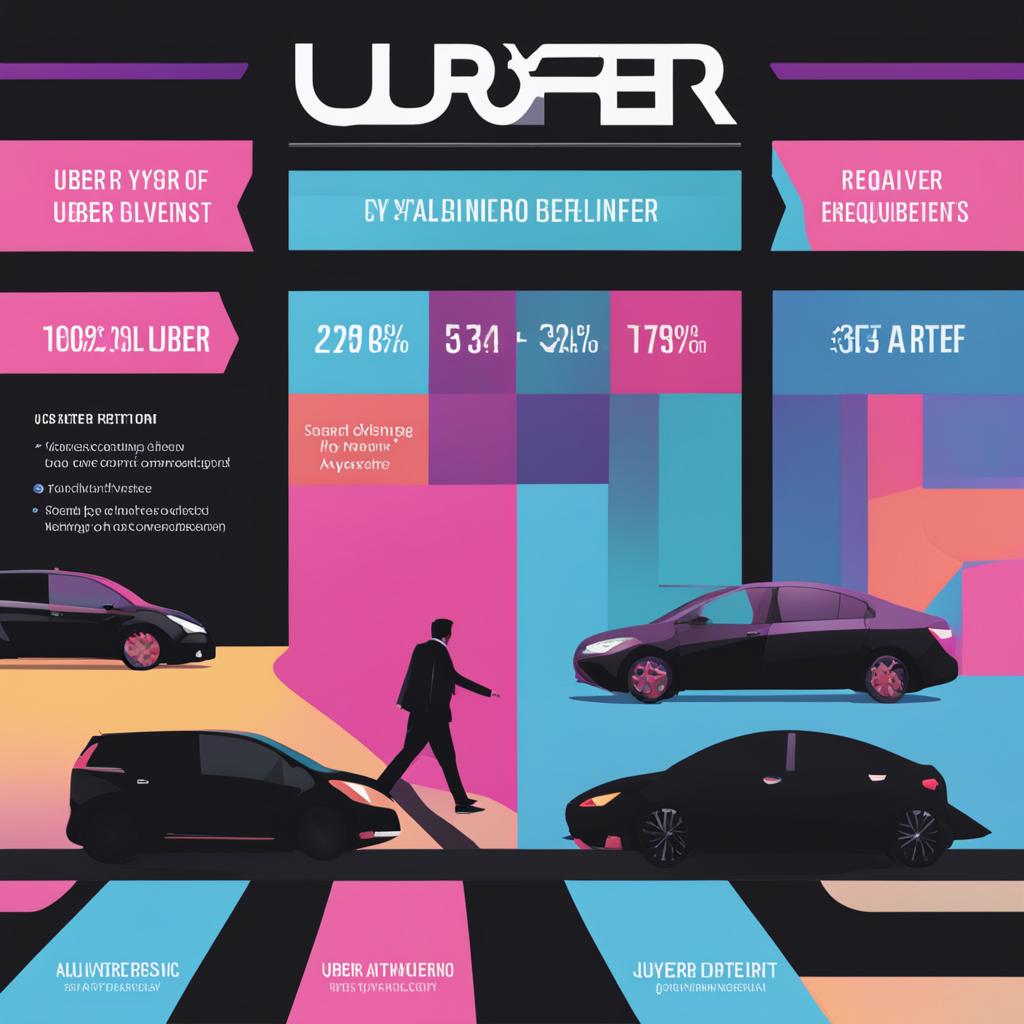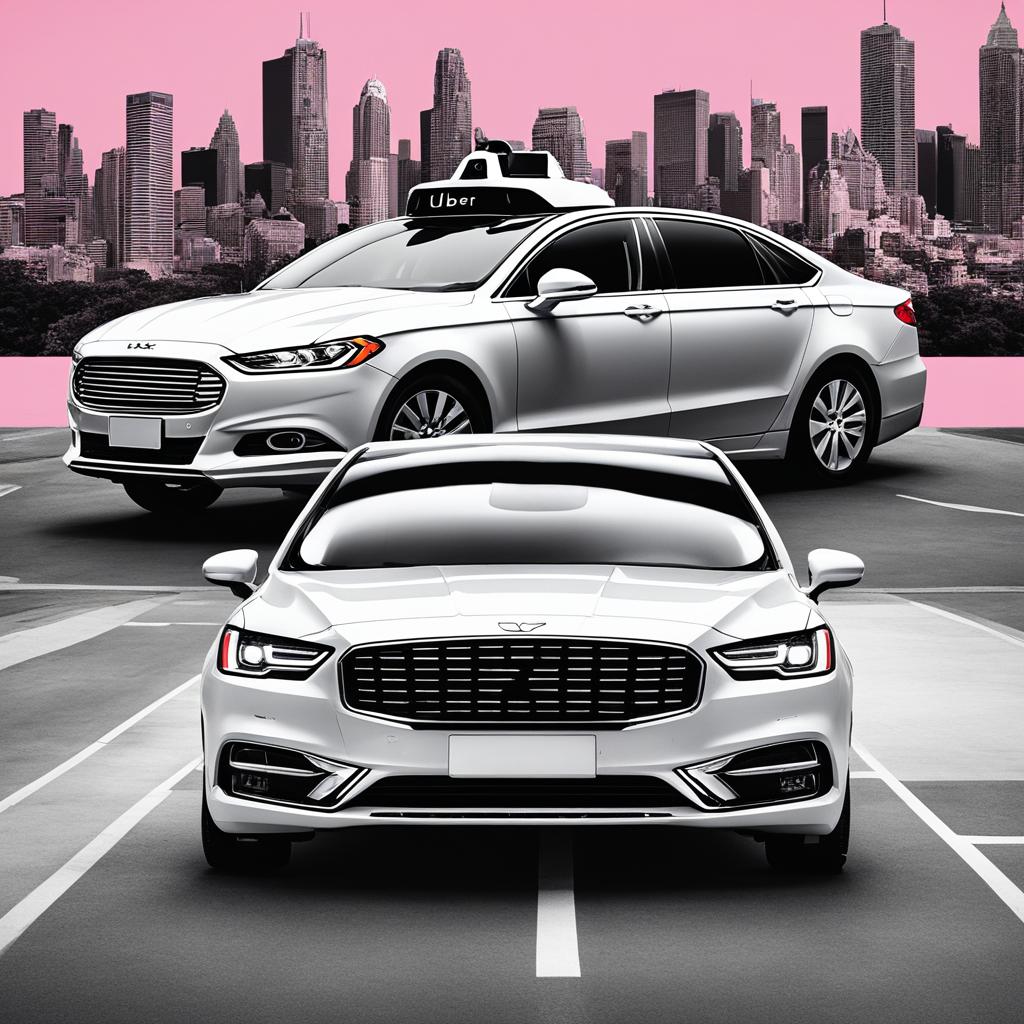When it comes to choosing the best ridesharing service for drivers, the competition between Uber and Lyft is undoubtedly at the forefront. Both platforms offer opportunities for individuals to earn income by providing rides to passengers. But which platform is truly the best fit for drivers? Let’s take a closer look at the key factors to consider.
Key Takeaways:
- Uber and Lyft are the leading players in the ridesharing industry.
- Earnings, flexibility, and driver benefits are crucial factors to consider.
- Uber generally offers higher nationwide earnings compared to Lyft.
- Uber has a broader global reach, operating in over 90 countries.
- Both platforms have user-friendly apps, but with slight differences.
Now, let’s dive into the details and analyze these key factors to determine which ridesharing platform reigns supreme for drivers.
Earning Potential
When comparing the earning potential of Uber and Lyft drivers, nationwide data suggests that Uber drivers generally earn more than their Lyft counterparts. This can be attributed to the fact that Uber drivers tend to spend more time on the road, resulting in higher hourly pay. However, it is important to note that earnings can vary based on several factors, including location, commissions, and other variables.
Should drivers prioritize maximizing their earnings, it is worth considering the average hourly pay rates for both Uber and Lyft. According to recent data, Uber drivers typically earn around $17 to $22 per hour, while Lyft drivers tend to earn slightly less, with hourly rates ranging from $15 to $20. These figures provide a general idea of the earning potential drivers can expect on each platform, but it is important to remember that these numbers are averages and can vary depending on several factors.
To further illustrate the earning potential disparity between Uber and Lyft, below is a comparative table detailing the average pay rates and earning potential for both platforms:
| Platform | Average Hourly Pay | Potential Earnings |
|---|---|---|
| Uber | $17 – $22 | Varies based on location, hours worked, and other factors |
| Lyft | $15 – $20 | Varies based on location, hours worked, and other factors |
As depicted in the table, the earning potential for Uber drivers generally surpasses that of Lyft drivers. However, it is essential to consider individual circumstances and market dynamics when evaluating earning potential on each platform.
“I switched from Lyft to Uber because I noticed a considerable increase in my earnings. By driving for Uber, I was able to earn a higher hourly wage due to the increased demand and more extensive coverage.
According to testimonies from drivers who have made the switch from Lyft to Uber, many report experiencing a noticeable improvement in their earning potential. The wider availability and larger customer base of Uber contribute to more consistent ride opportunities and higher overall earnings.
While Uber may provide better earning potential in general, it is still important for drivers to assess their personal circumstances, such as local market conditions or specific preferences, before making a decision. Evaluating the earning potential alongside other factors, such as coverage, app features, and promotions, will provide a more comprehensive understanding when choosing between Uber and Lyft as a rideshare platform.
Coverage
When it comes to coverage and availability, Uber surpasses Lyft with its extensive reach. While both Uber and Lyft operate in the United States and Canada, Uber’s services extend far beyond these countries, making it available in over 90 countries worldwide. This global presence gives Uber a significant advantage in terms of serving drivers from various parts of the world.
With Uber’s wide-ranging coverage, drivers have the opportunity to find more passengers and earn consistently in different markets. Whether you’re driving in major cities or exploring remote areas, Uber’s expansive network ensures that drivers have a higher chance of finding riders and maximizing their earning potential.
On the other hand, Lyft primarily focuses on the United States and Canada. While it has a strong presence in these regions, Lyft’s limited availability outside of North America can be a drawback for drivers looking to expand their opportunities internationally.
To illustrate the geographical coverage of Uber and Lyft, below is a comparison table showing the countries where each company operates:
| Uber | Lyft |
|---|---|
|
|
This table clearly demonstrates Uber’s global presence, encompassing countries across multiple continents. In contrast, Lyft’s operations are more localized, primarily serving users within North America.
In conclusion, when it comes to coverage and availability, Uber has the upper hand, providing drivers with a broader range of opportunities in various countries around the world.
Image: Uber’s extensive global coverage provides drivers with opportunities in over 90 countries.
Pay
When it comes to earning potential, the pay structure of Uber and Lyft plays a crucial role. Both platforms compensate drivers based on mileage and time, but there are some key differences to consider.
Commission Rates:
Uber deducts a higher commission rate of 25% from the total fare, while Lyft takes a slightly lower commission of 20%. This means that Uber drivers receive a smaller percentage of the fare compared to Lyft drivers.
Tipping:
Both Uber and Lyft allow riders to leave tips, which can significantly impact a driver’s earnings. However, Uber provides a longer tipping window of up to 30 days, while Lyft only allows riders to tip within 72 hours. This gives Uber drivers a longer opportunity to receive additional income through tips.
Overall, when considering the pay structure, it’s important for drivers to weigh the higher commission rate of Uber against the potential for larger tips within a longer tipping window. Now, let’s dive deeper into the other aspects of Uber and Lyft to get a comprehensive understanding of which platform is best for drivers.
Continue reading Section 5: Number of Rides to explore how the ride volume differs between Uber and Lyft, and how it impacts driver earnings.
Number of Rides
When it comes to driving for Uber or Lyft, the number of rides you receive can greatly impact your earnings. With Uber, drivers tend to have access to a higher volume of rides compared to Lyft. This means more opportunities to pick up passengers and make money on the road.
Ride volume can vary depending on factors such as market size and demand. In larger cities with a higher population, there may be more ride requests overall, increasing the potential for drivers to stay busy and maximize their earnings.
It’s important to note that while Uber generally offers a higher ride volume, Lyft can still provide a steady flow of ride requests, especially in certain markets and during peak hours. Understanding the ride volume dynamics in your specific area can help you make an informed decision on which platform to choose as a rideshare driver.
The image above illustrates the concept of ride volume, showcasing the dynamic nature of the rideshare industry and the potential for drivers to receive a high volume of ride requests.
App Features
When it comes to app features, both Uber and Lyft prioritize a user-friendly experience for their drivers. Let’s take a closer look at the unique features offered by each platform:
Uber App Features
Uber’s app provides drivers with comprehensive in-app navigation options, allowing seamless integration with various GPS services. This feature ensures that drivers can easily navigate to pick-up and drop-off locations, saving time and optimizing their driving routes. Whether it’s a familiar neighborhood or a new destination, Uber’s in-app navigation provides real-time guidance to help drivers reach their destinations efficiently.
Lyft App Features
Similarly, Lyft’s app also offers navigation features powered by Google Maps. The Lyft app’s interface is known for its simplicity and intuitive design, enabling drivers to easily access information and navigate through the app effortlessly. With the integration of Google Maps, drivers can rely on accurate directions and real-time traffic updates, ensuring a smooth and efficient driving experience.
“Having user-friendly navigation features is essential for rideshare drivers. Both Uber and Lyft prioritize this aspect, ensuring that drivers can easily navigate to their destinations and provide a seamless experience for their passengers.”
Driver Promotions
Both Uber and Lyft offer exciting promotions and bonuses to motivate and reward their drivers. These promotions can be a great way for drivers to maximize their earnings and take advantage of additional incentives. Let’s take a closer look at the driver promotions offered by both Uber and Lyft.
Uber Promotions
Uber provides a range of promotions and quests that offer drivers the opportunity to earn more money. One popular promotion is the weekly quest, where drivers have the chance to earn extra money by completing a certain number of trips within a specified time period. Uber also offers surge pricing during peak demand times, allowing drivers to earn more per trip.
Additionally, Uber occasionally runs special promotions and bonuses for drivers, such as referral bonuses for bringing new drivers onto the platform. These promotions can provide a significant boost to a driver’s earnings and make driving for Uber even more rewarding.
Lyft Promotions
While Lyft also offers promotions and bonuses, the availability and scope of these promotions may vary by location. Some Lyft drivers have reported receiving fewer promotions in certain markets compared to their counterparts driving for Uber.
Lyft’s driver promotions typically include bonuses for completing a certain number of rides within a specific time frame. These bonuses can be a great way for drivers to earn extra money and increase their overall earnings. However, it’s important for drivers to check and follow the specific promotions available in their area to take full advantage.
| Uber Promotions | Lyft Promotions |
|---|---|
| Weekly quests | Bonuses for completing a certain number of rides |
| Surge pricing during peak demand | Varying promotions by location |
| Referral bonuses |
As seen in the table above, Uber offers a wider range of promotions and earning opportunities for drivers compared to Lyft. It’s important for drivers to keep an eye out for the latest promotions from both platforms and leverage them to maximize their earnings.
Overall, driver promotions and bonuses can play a significant role in a driver’s earning potential and overall satisfaction. Whether you choose Uber or Lyft, taking advantage of these promotions can help you make the most out of your rideshare driving experience.

Safety Features
When it comes to driver safety, both Uber and Lyft prioritize implementing various safety features to ensure a secure and comfortable experience for their drivers. Let’s take a closer look at the safety measures offered by both platforms:
Safety Features in Uber
1. Trip Recording: Uber provides a trip recording feature that allows drivers to capture audio during their trips. This feature aims to promote accountability and maintain a safe environment for both drivers and passengers.
2. Safety Reminders: Uber regularly sends safety reminders to drivers, emphasizing the importance of following local traffic laws, wearing seat belts, and adhering to company policies. These reminders serve as a helpful tool in promoting driver awareness and responsibility while on the road.
3. Enhanced Ride Check: Uber’s enhanced ride check feature uses GPS and accelerometer data to detect possible anomalies during a trip, such as long stops or unexpected route changes. If any such issues are identified, Uber reaches out to both drivers and riders to ensure their safety and well-being.
Safety Features in Lyft
1. Personal Safety Features: Lyft offers features such as 24/7 in-app emergency assistance, the ability to easily share ride details with trusted contacts, and an option to contact 911 directly from the app. These features are designed to provide drivers with additional layers of security and peace of mind during their rides.
2. Driver Feedback Loop: Lyft has implemented a driver feedback loop that enables drivers to report safety concerns or issues they may have experienced during their rides. This mechanism allows Lyft to gather valuable feedback from drivers and take appropriate actions to address any safety concerns.
3. Ongoing Safety Enhancements: Lyft continually invests in research and development to introduce new safety features and enhancements for its drivers. This includes updates to the app’s safety features and improvements based on feedback from drivers and industry best practices.
Both Uber and Lyft are committed to maintaining a safe environment for their drivers and passengers. While Uber offers features such as trip recording and enhanced ride check, Lyft focuses on personal safety features and a driver feedback loop. It’s crucial for both platforms to continue enhancing their safety measures to ensure the well-being of their drivers and passengers.
Gas Surcharge
When it comes to the cost of gas, rideshare drivers understand that it can significantly impact their earnings. In an effort to mitigate this expense, Uber recently introduced a temporary fuel surcharge for its drivers.
This gas surcharge is designed to provide additional compensation to Uber drivers specifically for their gas expenses. By implementing this surcharge, Uber aims to support their drivers in managing their fuel costs and ensuring they can continue to operate efficiently on the platform.
On the other hand, Lyft does not offer a specific gas surcharge for its drivers. However, it’s important to note that Lyft may have alternative ways for drivers to offset their gas expenses. It’s worth exploring Lyft’s driver resources and incentives programs to discover if there are any opportunities for gas expense compensation or reduction.
Ultimately, whether you choose to drive for Uber or Lyft, the gas surcharge offered by Uber can be a significant factor in considering the potential impact on your earnings and overall profitability as a rideshare driver.
To gain a better understanding of the earnings potential and costs associated with driving for Uber and Lyft, let’s take a closer look at our side-by-side comparison of the two platforms:

Gas Surcharge Comparison
| Rideshare Platform | Gas Surcharge |
|---|---|
| Uber | Yes |
| Lyft | No |
Food Delivery
When it comes to food delivery service, Uber takes the lead with Uber Eats, providing drivers with the opportunity to earn additional income by delivering food, groceries, and even alcohol. This service has become increasingly popular, offering customers a convenient way to satisfy their cravings without leaving the comfort of their homes. With Uber Eats, drivers can tap into a growing market and expand their earning potential beyond traditional ridesharing.
Lyft, on the other hand, does not currently offer a similar food delivery service. While Lyft focuses primarily on passenger transportation, Uber has recognized the demand for food delivery and capitalized on the opportunity by integrating Uber Eats into their platform. This strategic move has allowed Uber to establish a significant advantage over Lyft in the realm of food delivery.
Velvety Tips
One of the key aspects of being a rideshare driver is the opportunity to receive tips from riders. Both Uber and Lyft provide in-app tipping options that allow riders to show their appreciation for excellent service. However, there is a slight difference between the two platforms when it comes to the tipping policy.
Uber has a generous tipping policy that allows riders to leave a tip for up to 30 days after the ride. This extended tipping window gives riders more flexibility, allowing them to reflect on their ride experience before deciding on a tip amount.
On the other hand, Lyft offers a shorter tipping window, allowing riders to leave a tip for up to 72 hours after the ride. While this may be a more immediate opportunity for drivers to earn tips, it limits the time frame in which riders can express their gratitude.
With its longer tipping period, Uber takes the lead in this category. The extended window for tipping provides drivers with a greater chance of receiving additional income, even after the ride has been completed. This can make a significant difference for drivers seeking to maximize their earnings.

Overall, both Uber and Lyft recognize the importance of tipping in the rideshare industry and provide mechanisms for riders to express their gratitude. However, Uber’s policy of allowing tips for up to 30 days sets it apart and positions it as a platform where drivers may have a better chance of earning additional income through tips.
Earning Potential Summary
After analyzing various factors including earning potential, pay structure, ride volume, and additional features, it is evident that Uber holds the advantage in terms of overall earning potential for drivers. While Lyft offers competitive opportunities, Uber’s higher earnings and broader market reach make it a compelling choice for drivers seeking to maximize their total earnings.
However, it is important to acknowledge that individual market conditions and personal preferences can play a significant role in determining the best ridesharing platform for drivers. What works well for one driver may not be the ideal choice for another. Therefore, it is recommended for aspiring and current drivers to carefully evaluate their local market dynamics and consider their own preferences when making a decision.
| Factors | Earnings Potential | Market Reach | Additional Features |
|---|---|---|---|
| Uber | High | Global | Uber Eats |
| Lyft | Competitive | US, Canada | – |
In terms of earnings potential alone, Uber consistently ranks higher as compared to Lyft. The broader market reach of Uber, available in over 90 countries, allows drivers to access more ride opportunities, increasing their earning potential. Additionally, Uber’s introduction of Uber Eats provides an additional avenue for drivers to earn income through food delivery services.
However, it is essential to weigh the pros and cons of each platform, considering factors such as pay structure, demand in specific markets, and driver preferences. In certain situations, Lyft may present more attractive options for drivers based on local market conditions or personal preferences.
The image above visually highlights the earning potential comparison between Uber and Lyft, offering a clear overview of the differences in earnings. This comparison charts the average earnings per hour for drivers across different cities, showcasing Uber’s consistently higher earnings.
Eligibility Requirements
When considering becoming a driver for either Uber or Lyft, it’s important to understand the eligibility requirements. Both platforms have similar criteria to ensure the safety and reliability of drivers and passengers. Here are the key requirements for becoming an Uber or Lyft driver:
- Valid Driver’s License: You must have a valid driver’s license issued by your state of residence.
- Insurance: You need to provide proof of insurance that meets the minimum requirements set by Uber or Lyft.
- Proof of Residency: You must be able to provide documentation showing your residency in the city or state where you plan to drive.
By meeting these requirements, you can ensure the safety and security of both yourself and your passengers. It’s important to note that specific requirements may vary by city and state, so it’s always a good idea to check the Uber and Lyft websites for detailed information based on your location.
Joining either Uber or Lyft as a driver is a great way to earn income on your own schedule. With their extensive driver networks and user-friendly apps, both platforms provide flexibility and earning potential. So if you meet the requirements and are ready to hit the road, sign up today!

| Requirements | Uber | Lyft |
|---|---|---|
| Valid Driver’s License | ✔️ | ✔️ |
| Insurance | ✔️ | ✔️ |
| Proof of Residency | ✔️ | ✔️ |
Conclusion
After comparing Uber and Lyft as rideshare platforms for drivers, it is clear that both have their strengths and weaknesses. When it comes to earnings and global reach, Uber tends to have the upper hand. However, Lyft may offer advantages in specific markets.
Ultimately, the best choice between Uber and Lyft depends on individual preferences, local market conditions, and personal goals as a rideshare driver. It’s important to consider factors such as earning potential, coverage, pay structure, and additional features provided by each platform.
For drivers seeking higher earnings and a wider scope of opportunities, Uber is often considered the preferred option. With a larger customer base and a presence in over 90 countries, Uber provides drivers with a greater potential for earning. Additionally, Uber’s in-app navigation and extended tipping period offer added convenience for drivers.
On the other hand, Lyft may have its advantages in certain markets. The platform’s user-friendly interface and simpler app features make it a choice worth considering, especially for drivers who prioritize ease of use. In addition, Lyft’s driver promotions and bonuses can be attractive in specific locations.
When making the decision between Uber and Lyft, it’s crucial to weigh the pros and cons, considering individual circumstances and goals. Drivers should assess their local market demand, evaluate the earning potential, and prioritize features that align with their preferences.
Ultimately, the choice between Uber and Lyft should be based on the specific needs and priorities of each driver. With careful consideration and research, drivers can make an informed decision, selecting the rideshare platform that best suits their goals and preferences.
Expert Opinion:
“As an experienced professional in the ridesharing industry, I recommend that drivers carefully evaluate their local market conditions and personal goals when choosing between Uber and Lyft. While Uber generally offers higher earnings and a broader reach, Lyft may have its advantages in specific markets. Take the time to assess your individual needs and priorities to make an informed decision.” – [Expert Name], Ridesharing Consultant
Unique Insights and Expert Opinions
As a financial professional expert in the ridesharing industry, I provide unique insights and opinions based on my experience and analysis. When it comes to deciding between Uber and Lyft as a rideshare platform for drivers, it’s crucial to consider various factors to make an informed choice. While both platforms offer opportunities for drivers, understanding the nuances can help maximize your earnings and enhance your overall experience.
One important aspect to consider is the earning potential. While Uber drivers generally earn more due to the higher ride volume, this may vary based on your location and market conditions. Additionally, it’s essential to assess the pay structure, including commissions and tipping policies, as they directly impact your take-home earnings.
Another key factor is the availability and coverage of both platforms. While Uber has a wider global presence in over 90 countries, Lyft may provide better availability in specific markets. Evaluating the geographical reach can help determine which platform aligns better with your goals and driving preferences.
Ultimately, the choice between Uber and Lyft depends on your individual circumstances. I am here to provide personalized advice and recommendations tailored to your specific needs. Reach out to me for expert insights that can guide you in making the best decision as a rideshare driver.
FAQ
Which rideshare service, Uber or Lyft, is better for drivers?
The answer depends on various factors such as earning potential, coverage, driver benefits, and personal preferences. Let’s take a closer look at the details to help you make an informed decision.
What is the earning potential for drivers on Uber and Lyft?
Uber drivers generally earn more than Lyft drivers nationwide due to higher hourly pay. However, earnings can vary based on location, commissions, and other factors.
Which rideshare service has better coverage and availability for drivers?
Uber has a broader global reach, available in over 90 countries, compared to Lyft’s operations in the United States and Canada. This gives Uber the advantage in terms of coverage and availability for drivers.
How do Uber and Lyft pay drivers?
Both Uber and Lyft pay drivers based on mileage and time. However, Uber deducts 25% from the total fare as a commission, while Lyft’s commission rate is 20%. Additionally, both platforms allow riders to tip drivers within the app.
Which rideshare service offers more ride opportunities for drivers?
Uber generally offers more ride opportunities compared to Lyft, resulting in a higher volume of rides for drivers. However, this can vary depending on market size and demand.
What app features do Uber and Lyft offer for drivers?
Both Uber and Lyft offer user-friendly apps for drivers. Uber provides in-app navigation options with integration from various GPS services, while Lyft’s app also utilizes Google Maps for navigation but offers a simpler interface.
Do Uber and Lyft offer promotions and bonuses for drivers?
Both Uber and Lyft offer driver promotions and bonuses to incentivize drivers. Uber’s promotions and quests often provide higher earning opportunities, including weekly quests and surges. Lyft’s promotions may vary by location.
What safety features do Uber and Lyft have for drivers?
Uber has introduced trip recording, safety reminders, and enhanced ride check features for driver safety. Lyft also focuses on driver safety with safety features but may have room for improvement, according to feedback from female drivers.
Does Uber or Lyft offer a gas surcharge for drivers?
Uber recently introduced a temporary fuel surcharge for drivers to provide additional compensation for gas expenses. Lyft does not offer a specific gas surcharge but may have other ways for drivers to offset costs.
Does Lyft offer a food delivery service like Uber Eats?
No, Lyft does not currently offer a food delivery service. Uber, on the other hand, has Uber Eats, which allows drivers to earn additional income by delivering food, groceries, and even alcohol.
Can riders leave tips for drivers on Uber and Lyft?
Both Uber and Lyft allow riders to tip drivers within the app. However, Uber provides a longer window of up to 30 days for riders to leave a tip, while Lyft only allows up to 72 hours.
Which rideshare service has better earning potential for drivers overall?
Considering factors such as earning potential, pay structure, ride volume, and additional features, Uber appears to have the edge in terms of overall earning potential for drivers. However, individual market conditions and personal preferences should also be considered.
What are the eligibility requirements for Uber and Lyft drivers?
Both Uber and Lyft have similar eligibility requirements for drivers, including a valid driver’s license, insurance, and proof of residency. However, detailed requirements can vary by city and state.
Which rideshare platform should I choose as a driver, Uber or Lyft?
The best choice between Uber and Lyft as a rideshare platform for drivers depends on various factors such as earning potential, coverage, app features, and personal goals. Evaluating individual market conditions and preferences is crucial in making the right decision.
Can I reach out to you for personalized advice and recommendations on the Uber vs Lyft debate for drivers?
Yes, as a financial professional expert in the ridesharing industry, I provide unique insights and opinions based on my experience and analysis. Feel free to reach out to me for more personalized advice and recommendations.
Our Friends
- https://therideshareguy.com/uber-vs-lyft/
- https://www.fool.com/the-ascent/personal-finance/articles/uber-vs-lyft-who-pays-drivers-more/
- https://millennialmoney.com/uber-vs-lyft/
Money posts:
 Uber vs. Lyft Driver: Who Pays Better? (2024)
Uber vs. Lyft Driver: Who Pays Better? (2024)
 Instacart vs. DoorDash: Which is Best for Drivers in (2024)?
Instacart vs. DoorDash: Which is Best for Drivers in (2024)?
 Is DoorDash Worth It? 7 Things Drivers Can Expect (2024)
Is DoorDash Worth It? 7 Things Drivers Can Expect (2024)
 Top 23 Legit Money Making Apps to Download For Your [Year]
Top 23 Legit Money Making Apps to Download For Your [Year]
 Wells Fargo Promotions and Bonuses 2024
Wells Fargo Promotions and Bonuses 2024
 Top 22 Ways to Make $10 a Day (2024)
Top 22 Ways to Make $10 a Day (2024)
 55 Best Money-Making Apps (2024)
55 Best Money-Making Apps (2024)
 Is Blitz Win Cash Legit? Review (2024)
Is Blitz Win Cash Legit? Review (2024)

